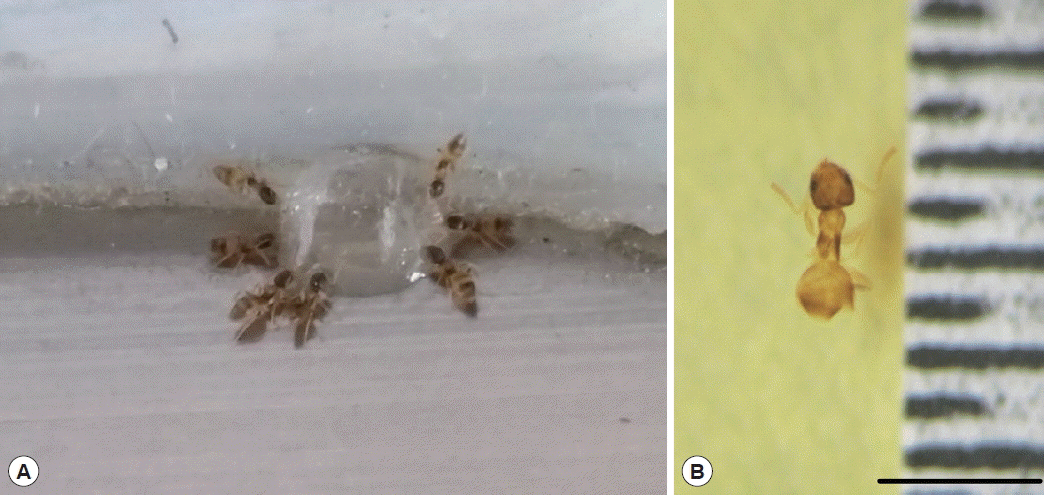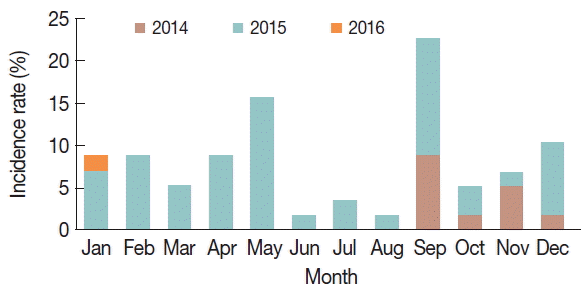Indoor Occurrence of the Ghost Ant Tapinoma melanocephalum (Hymenoptera: Formicidae) in Urban Homes in Korea
Article information
Abstract
The ghost ant Tapinoma melanocephalum is a common household pest worldwide. The present study examined the occurrence of the species in urban homes in Korea. During the period of September 2014 to January 2016, T. melanocephalum workers were collected from 58 homes at 29 different localities using bait traps with 10% sugar solution. The species was widely distributed throughout urban homes at 29 different localities, and the indoor occurrence of T. melanocephalum was highest in Seoul (32.7%) and metropolitan areas of Gyeonggi-do (Province) (29.3%). The indoor incidence rate of T. melanocephalum peaked in September (22.8%), remained moderate from October through April, and peaked again in May (15.7%). In contrast, a low incidence was observed from June to August (7.0%). The present study provides evidence that native ants, such as T. melanocephalum, are potential indoor pests of homes in Korea throughout the year.
The ghost ant Tapinoma melanocephalum (Fabricius, 1793) is a ubiquitous indoor and outdoor pest throughout much of the tropics and subtropics, and an increasingly common indoor pest in temperate regions (Europe, North America, China, and Japan). In colder climates, the species has been found in places with high humidity and temperature, such as apartments, restaurants, hospitals, and greenhouses [1–3]. Although T. melanocephalum does not sting and its bite is not painful, it can be a public health risk and can damage food. The species has been known since 1887; however, records of its occurrence have increased with the rise of globalization and global trade [4–7].
In Korea, the origin of indoor infestations by T. melanocephalum is not clear, but such infestations were first reported in 2005 [1]. There are up to 135 known species of ants in Korea [8], and 2 species, the Pharaoh ant (Monomorium pharaonis) and Asian needle ant (Pachycondyla chienesis), are considered major urban pests [9,10]. The aims of the present study were to investigate the distribution and monthly incidence of T. melanocephalum. To our knowledge, this is the first investigation of T. melanocephalum in urban homes in Korea.
During the period of September 2014 to January 2016, invasive ants were collected from 58 homes by placing 3 bait traps with a 10% sugar solution on kitchen room for 1 day, and the homes were distributed among 29 localities, including Seoul (19), Inchon (3), Paju (1), Goyang (3), Gimpo (1), Anyang (2), Gwangmyeong (1), Seongnam (3), Suwon (1), Hanam (1), Guri (1), Uiwang (1), Ansan (1), and Pyeongtack (1) in Gyeonggi-do (Province), Goseong (1) in Gangwon-do; Asan (1), Cheonan (1), and Daejeon (1) in Chungcheongnam-do; Chungju (1) and Cheongju (1) in Chungcheongbuk-do; Jeonju (4) and Iksan (1) in Jeollabuk-do; Gwangju (1) in Jeollanam-do; Gumi (1), Andong (1), Daegu (1), and Gyeongju (1) in Gyeongsangbuk-do; and Jinju (1) and Busan (2) in Gyeongsangnam-do.
The collected ants were identified under a stereomicroscope. They were identified as T. melanocephalum workers (Fig. 1A). The ants were small (average ≥1 mm). Their shapes were distinctly bicolored, with the head (except for the first 2 antennae segments) and mesosoma being dark brown to blackish-brown and the appendages, petiole, and gaster being milky white. The eyes were large, the antennae had 12 segments, the thorax was spineless, the gaster was hairless, and the abdomen had no stinger (Fig. 1B).

Ghost ant (Tapinoma melanocephalum) workers. (A) T. melanocephalum at a bait trap with 10% sugar solution. (B) Dorsal view. Scale bar=1 mm.
The indoor occurrence of T. melanocephalum differed by locality (Table 1). The results were higher in Seoul (32.7%) and in Gyeonggi-do (29.3%) than in Chungcheongnam-do (5.2%), Chungcheongbuk-do (3.5%), Jeollabuk-do (8.6%), Jeollanam-do (1.7%), Gyeongsangbuk-do (6.9%), Gyeongsangnam-do (1.7%), and Busan (3.5%). No ghost ants were observed in the home in Goseong, Gangwon-do.
The indoor incidence rate of T. melanocephalum started to increase in September (22.8%), remained moderate from October through April, and peaked again in May (15.7%), whereas a low incidence was observed from June to August (Fig. 2). Therefore, 29.8, 7.0, 35.1, and 28.1% of the total infestations were observed during the spring (March–May), summer (June–August), autumn (September–November), and winter (December–February), respectively.

Total monthly incidence rate of the ghost ant Tapinoma melanocephalum in urban homes from September 2014 to January 2016 in Korea.
The second half of the twentieth century and the beginning of the twenty-first century have witnessed important changes in ecology, climate, and human behavior that favor the development of urban pests. Most alarmingly, urban planners are now faced with the dramatic expansion of urban sprawl, whereby the suburbs of cities are exposed to the natural habitats of ticks, rodents, and other pests. In addition, many city managers now erroneously assume that pest-borne diseases are relics of the past [11], and globalization is increasing the spread of various vector-borne diseases and urban pests [12]. Ants live with humans and are readily adapted to urban environments across the globe.
In the present study, the ghost ant T. melanocephalum was found to be widely distributed throughout urban homes at 29 different localities in Korea throughout the year. Therefore, it is clear that T. melanocephalum is a new indoor ant species in Korea. This species is known to transport pathogenic microbes [3–7], and in some people, contact with the ant can cause a slight, red irritation of the skin [13].
T. melanocephalum is similar to the Pharaoh ant Monomorium pharaonis in shape, and the 2 species are quite difficult to distinguish with the naked eye. However, T. melanocephalum workers can be easily identified by their extremely small size and peculiar color markings; moreover, T. melanocephalum workers possess only a single pedicel node, whereas M. pharaonis workers possess 2 pedicel nodes. M. pharaonis is a major indoor pest worldwide [9] that has an abdomen that is darker than its thorax and head. The behavior and nesting habits of M. pharaonis resemble those of T. melanocephalum, in that they are most active in kitchens and pantries.
One of the problems that have emerged from urbanization is the use of different habitats by a great variety of insects [14]. Urbanization has spread across the globe rapidly and has generated various health problems and urban pests. According to a report from the Ministry of Land, Infrastructure and Transport, Korea (http://onnora.kr), the rate of urbanization in Korea has risen drastically from 35.8% in 1960 to 90.6% in 2015, and the census statistics of 2015 (http://kosis.kr) indicate that the metropolitan areas of Korea (Seoul, Incheon, and Gyeonggi-do) contain 49.5% of the total population, with apartments representing 59.9% of the housing and houses representing 40.1%.
The present study indicated that 78.9% of the T. melanocephalum infestations occurred in apartments and 21.0% occurred in houses (Table 1), and 67.2% of the T. melanocephalum infestations in Seoul, Incheon, and Gyeonggi-do occurred in homes. These results suggested that a correlation exist between population density and housing type in urban environments.
The reason that higher rates of T. melanocephalum infestation are observed in metropolitan areas (Seoul and Gyeonggi-do) than in other provinces is that T. melanocephalum infestation is associated with higher population densities and greater densities of well-heated apartments.
T. melanocephalum cannot survive outdoors in colder climates, and in these regions, the species is only found in heated buildings and greenhouses [1]. In addition, T. melanocephalum prefers to live at 25–30°C and with a relative humidity of 96% but does well within a moderate range of these values [15]. In general, the nests of T. melanocephalum are situated in inaccessible, warm, and moist areas that are close to a food source. Typical nest locations include plant pots, wall voids, behind tiling, cupboards in kitchens and bathrooms, meter boxes, and plug sockets [16].
In the present study, 93.0% of the infestations were observed from September to May, whereas only 7.0% were observed in the summer (June–August, Fig. 2). Most of the indoor T. melanocephalum infestations that were established in September persisted until May, and the ants seemed to prefer outdoor sites during the summer. This suggests that T. melanocephalum cannot survive the colder outdoor temperatures that occur from autumn to spring and that T. melanocephalum is well suited to living in homes in Korea.
Today, ants are adapted to city living. The chances of ants surviving transport have increased, owing to the greater speed of modern transportation. Moreover, the diversity of products has increased, as has the number of countries from which such products originate. Increased tourism plays a role, as well, because ants can easily hide in plant materials or penetrate package materials [17]. Recent reviews of T. melanocephalum have reported that the species is adapted to urban life [1]. In Korea, the extent to which the infestation of T. melanocephalum has spread remains unclear. It was possibly spread through the movement of infested goods, plant products, luggage, or clothing by international tourists.
Pest ants in the urban environment have a significant impact on both the quality of human life and public health. Pest management strategies are required for safe and effective control. The best approach for controlling T. melanocephalum at home is cleanliness, especially since the nests of T. melanocephalum are often hidden. If post-infestation control is necessary, the ant is susceptible to a number of oral and contact insecticides [2]. The treatment method is the application of highly attractive bait products, especially if the whole house block is treated [16].
The present study provided evidence that, even though T. melanocephalum has had little time to become established in urban homes, it is possible that the species could become an increasingly common indoor pest and that the species could, someday, be found in every home in the country. Accordingly, we conclude that native ants, such as T. melanocephalum, are potential indoor pests of homes in Korea. Further studies that focus on the ecological niches and pathogens of T. melanocephalum, especially those relevant to humans, are needed.
ACKNOWLEDGMENT
This study was financially supported by the Arthropods of Medical Importance Resource Bank, Institute of Tropical Medicine, Yonsei University College of Medicine, Seoul 03722, Korea.
Notes
CONFLICT OF INTEREST
We have no conflict of interest related to this study.
